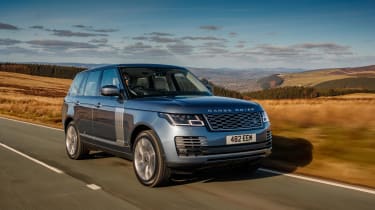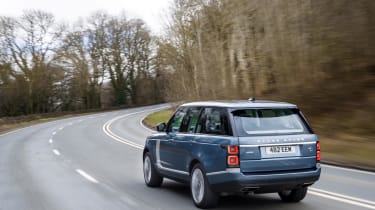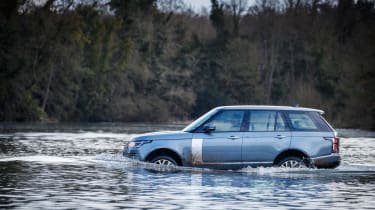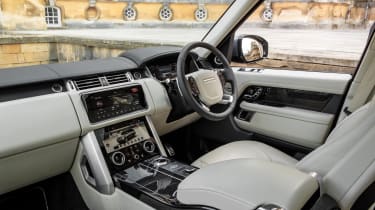Range Rover review (L405, 2012-2021) – verdict, specs and rivals
The modern Range Rover continues to define the luxury SUV just as its ancestors did, and despite strong rivals is still something special
Think of a luxury SUV and your first thought (in the UK anyway) is probably Range Rover. No one could've predicted just quite the impact the original Range Rover would have over the automotive world when it was unveiled 50 years ago. It single-handedly created the upmarket SUV segment and ever since has seen plenty of pretenders to its throne, but few, if any, have managed to topple it.
That’s because the Range Rover treads a fine line between being a capable off-roader and luxury cruiser. It’s equally at home down a soggy green lane, yet is every bit as prestigious, comfortable and luxurious as a Mercedes S-class on Park Lane. For the 2021 model year, Land Rover has widened its engine range with new in-line six diesel and petrol powertrain options, which is in addition to the plug-in hybrid and traditional supercharged V8s.
That the Range Rover can achieve this is nothing short of remarkable, but it does have its on-road compromises. We’d be lying if we said it’ll pursue well-driven sports cars on the Route Napoleon, but it will at least hang on to their bumpers for longer than it would have in previous generations, which isn’t saying much.
More reviews
In-depth reviews
Long term tests
Reviews
But if you had to choose just one car to do everything forever then the Range Rover would be impossible to argue against. It’s extraordinarily capable, its breadth of ability unsurpassed, even by more expensive and opulent machinery. Inside it’s sumptuously appointed, outside mercifully restrained and, as always, unimpeachably British with a capital B.
Range Rover: in detail
- Engine and gearbox and technical highlights > The engine range has changed over recent years, with two new straight-six Ingenium engines in petrol and diesel forms, a plug-in and the usual supercharged V8s
- Performance and 0-60 time > No Range Rover is fast, but they’re not really meant to be. Best sit back and surf a slow wave of torque and let the masses race around you
- Ride and handling > Air springs and some other chassis hardware attempt to keep the mass under control, but physics don’t lie
- MPG and running costs > The P400e plug-in hybrid has impressive numbers, and kept to short-range driving can be quite efficient. The other models less so.
- Interior and tech > Lacks groundbreaking tech, but is sumptuous, elegant and wonderfully finished
- Design > It’s as imperious as it’s ever been, even with the latest trends’ best efforts to mess it up.
Prices, Specs and Rivals
Prices for the ‘big’ Range Rover (ie. not Sport, Velar or Evoque) start at £83,456 for the most basic D300 Vogue. For the 2021 model year, Land Rover has launched a range of limited-edition models, but all are based on the core Vogue, Vogue SE (+£4500) and Autobiography (+£9375) forms.
All versions are impressively well equipped though, with everything from Matrix LED headlights, a panoramic roof, heated windscreen, 20-inch wheels, high-spec ‘Windsor’ leather trim on the seats, dash and doors, to ambient lighting, three-zone climate control, a reverse camera and JLR’s Touch Pro Duo infotainment system standard across the range.
Upgrade to the Vogue SE and the 20-inch wheels are replaced with 21s, the chairs are finished with an even higher-grade semi-aniline leather that is also cooled and heated, front and rear. There’s also configurable ambient lighting, soft-close doors, 360-degree parking system and upgraded active safety systems.
For the full monty Autobiography, the sizable price jump takes the features list into Tolstoy territory with highlights including Pixel LED headlights, a sliding panoramic roof, soft-touch headlining, executive class rear seats, a further upgrade to the sound system, rear seat entertainment package, cabin preconditioning – the list goes on.
Sitting at the very top of the range is the SVAutobiography Dynamic which, as well as its 555bhp supercharged V8 engine, gains even more standard equipment including ‘hot stone’ massaging front and rear seats with a quilted leather finish, Pixel-laser headlights, privacy glass, 22-inch diamond-cut wheels, a perforated leather headlining, bespoke design elements on the grille, side gills, quad rear pipes and standard high metallic paints. All Range Rovers are also available in an extended palette of ultra metallic finishes too from an extra £4590.
There are also long-wheelbase Range Rovers available at around a £7000 premium, model-for-model from Autobiography trim upwards. Different powertrain options are then available independently of trim in lower four- and six-cylinder models, with the D350 engine option costing from £89,685, P400e plug-in from £89,385, the P400 petrol MHEV from £90,570 in standard Vogue trims, while the V8s are available in Autobiography and SVAutobiography Dynamic trims at £112,515 and £144,265 respectively.
Check all the right boxes for a LWB SVAutobiography supercharged V8 Range Rover with the two-tone paint option and some tailgate-mounted event seating and you’ll be knocking on the door of a £200k Range Rover; which still somehow sounds like reasonable value against rivals from Bentley and Rolls Royce.
Rivals? Well the Rolls Royce Cullinan is the ultimate luxury SUV at the moment, which despite looking more like a London cab than an actual London cab costs from £264,000 before options, which can extend right up to half a million pounds with enough boxes ticked on the invoice. It is a V12 though, and has a tangible uplift in quality, if not image. The Bentley Bentayga is far more of a threat to the Range Rover though, having consistently stolen some of its core customer base since it appeared in 2014. Priced from £133,100 it’s not massively more expensive either, and comes with the option of a more substantial V6 hybrid and W12 engines (the latter coming later in 2020).






